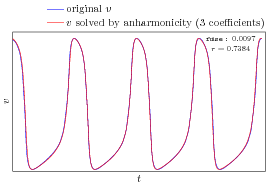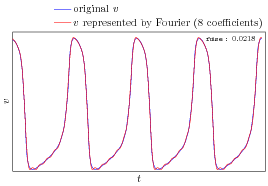Section: New Results
Quantification and Its Approximate Solution of Action Potential in Neuron Models by Anharmonicity Analysis
Participants : Binbin Xu, Hussein Yahia, Rémi Dubois.
Action potential (AP) plays an important role to initiate and maintain the cell-cell communication. The nerve impulses are extensively studied but the action potential is less investigated as in other types of cells (for example, cardiac action potential). The AP can tell more about the state of the cell. It reflects the physical / chemical intracellular exchanges. Any changes in the cell would change the form/geometry of AP, or a more relevant term the harmony. The intrinsic changes would modify the harmony of the impulses train. The broken harmony (form/geometry change) of the impulse train means that there would be some problems in the cell. This provides an indirect way to study the intrinsic dynamics the cells.
In the work of P. Hanusse proposed a very interesting signal analyzing approach by anharmonicity, especially for signals with nonlinear oscillations properties exhibited in many physical / biological systems. This is exactly the case for neuron impulses trains. The principle is to describing the signal with their harmonic behaviors by solving the nonlinear phase equation. The obtained phase is thus used to reconstruct a solution of the original signal. The key notion is the nonlinear trigonometry that they developed. According to this approach, for any periodic signal , its phase can be obtained by the proposed general solution which can be used to reconstruct the original signal .
There is no practical implementation in their papers. Here we propose a first order solution of the original analytical equation. It can be used to quantify the harmonicity of the action potential.
The phase of a signal can be solved as : so the signal can be reconstructed as . The related parameters can be obtained by regression or nonlinear optimization methods. In consequence, all AP can be quantified by the anharmonicity parameter .
|
FitzHugh-Nagumo (FHN) model has been one of the basic models to study the action potential's dynamics. It's derived from the Hodgkin-Huxley model and is physiologically correct. We take here dynamics of APs from FHN model to illustrate the anharmonicity analysis. As shown in the following figure, anharmonicity analysis is far more efficient than Fourier representation. Even with 8 Fourier terms, the signal is ill-represented with Gibbs phenomena. In contrast, 3 anharmonic terms exhibit a quasi-identical fit. These AP are quantified with an anharmonicity .
More development of anharmonicity analysis on AP is ongoing in order to provide a more efficient way to generalize the practices and for better solutions. We believe that anharmonicity analysis can help to quantify/qualify the AP in a different yet efficient way than conventional analysis.
One submitted publication.




